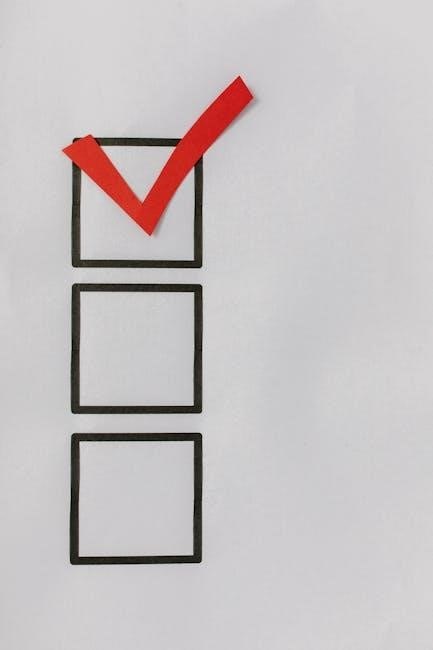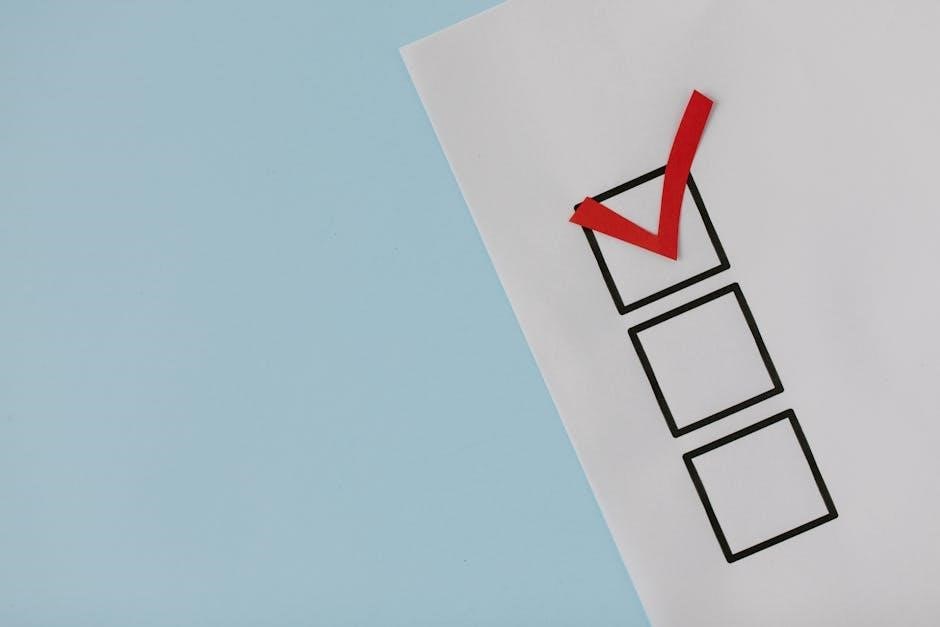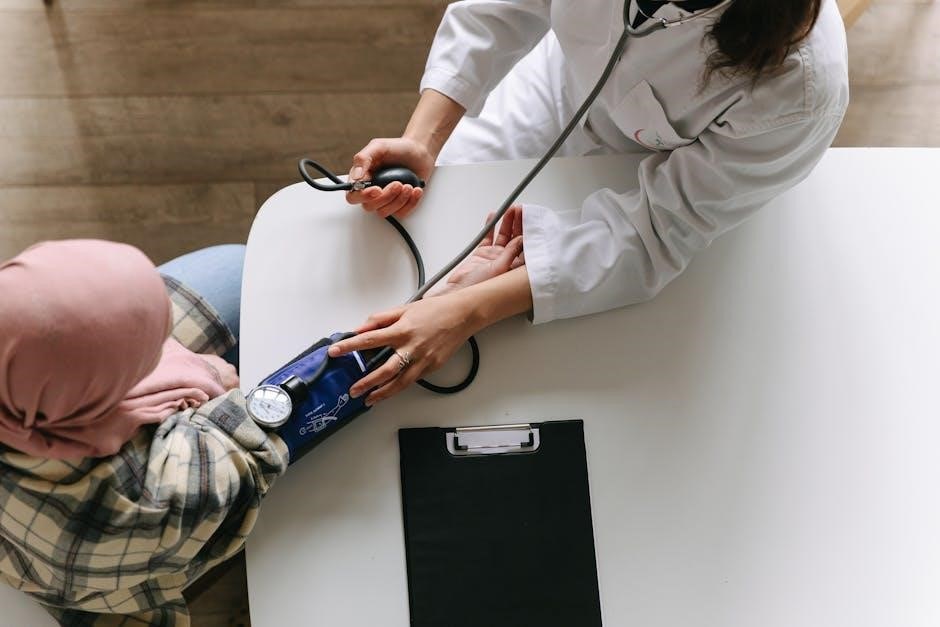
The Cessna 172 checklist is a detailed guide for pilots‚ covering critical phases from preflight to securing the aircraft. It enhances safety‚ reduces errors‚ and ensures efficient flight operations.
1.1 Importance of the Checklist in Flight Safety
A checklist is crucial for ensuring flight safety by systematically guiding pilots through critical procedures. It minimizes errors‚ enhances consistency‚ and reduces pilot workload. By following a structured approach‚ checklists help prevent oversights‚ especially during high-stress situations. They standardize operations‚ ensuring compliance with safety protocols and best practices. Regular use of a checklist is essential for maintaining situational awareness and achieving safe flight outcomes‚ covering all phases from preflight to shutdown.
1.2 Overview of the Cessna 172 Aircraft
The Cessna 172 Skyhawk is a widely used single-engine aircraft known for its reliability and versatility. With a four-seat capacity‚ it is popular for both training and personal flying. Its durability‚ ease of handling‚ and fuel efficiency make it a favorite among pilots. The aircraft is equipped with a Lycoming IO-360-L2A engine‚ offering excellent performance and stability. Its reputation as a safe and dependable aircraft has made it a cornerstone in aviation training and recreational flying worldwide.

Preflight Inspection Checklist
The preflight inspection ensures the aircraft is airworthy‚ covering external checks like tires and control surfaces‚ and internal checks of instruments and switches to guarantee safe operation.
2.1 External Aircraft Inspection
The external inspection involves checking the aircraft’s tires for proper inflation‚ ensuring control surfaces are free from damage‚ and verifying no obstructions are present in the air intakes or exhaust. Additionally‚ inspecting the propeller for nicks or cracks‚ ensuring all lights are functional‚ and examining the wings and fuselage for dents or damage is crucial for a safe flight. Proper fluid levels and absence of leaks should also be confirmed to prevent any issues during operation.
2.2 Internal Aircraft Inspection
The internal inspection includes checking the control locks‚ ignition switch‚ and avionics systems. Ensure the seatbelts and safety equipment are functional and properly secured. Verify the fuel selector is set to the correct tank and the mixture is in idle cutoff. Check for any obstructions in the cabin and ensure all necessary documents‚ such as the aircraft registration and pilot’s license‚ are present and valid. This step ensures a safe and legal flight environment.
2.3 Control Lock and Ignition Switch Checks
Ensure the control lock is removed to allow full movement of the flight controls. Verify the ignition switch is in the “OFF” position during preflight to prevent accidental engine start. Check that the avionics master switch is turned off to conserve battery power. This step ensures the aircraft is properly configured for a safe and successful engine start‚ aligning with standard safety protocols outlined in the Cessna 172 checklist.

Pre-Start Checklist
The pre-start checklist involves checking avionics‚ electrical systems‚ fuel selector‚ mixture settings‚ and seatbelts. Ensure the engine is primed and the area around the aircraft is clear.
3.1 Avionics and Electrical Systems
Switch on the avionics master and ensure all systems are functioning. Check navigation‚ communication‚ and flight instruments. Verify GPS and transponder settings. Test all warning lights and circuit breakers. Ensure the battery voltage is within range and all electrical systems are operational before starting the engine. This step ensures reliable performance of critical systems during flight.
3.2 Fuel Selector and Mixture Settings
Set the fuel selector to “BOTH” to ensure fuel flow from both tanks. Verify fuel quantity gauge indicates sufficient fuel for the flight. Mixture should be set to “RICH” for engine start. After start‚ lean the mixture to “LEAN” for optimal performance. Monitor fuel levels during flight and adjust the selector as needed to maintain balance. Proper fuel management ensures safe and efficient engine operation throughout the flight.
3.3 Seatbelts and Safety Equipment
Ensure all seatbelts and shoulder harnesses are securely fastened for all occupants. Verify the fire extinguisher is easily accessible. Check the first aid kit is onboard. Confirm the emergency locator beacon (ELT) is armed. Test the intercom system for clear communication. Brief passengers on safety procedures‚ emergency exits‚ and seatbelt usage. Properly secured seatbelts and accessible safety equipment are critical for passenger safety during takeoff‚ landing‚ and unexpected situations.

Engine Start and Taxi Checklist
Prime the engine‚ check fuel flow‚ and monitor gauges during start. Ensure proper communication with tower. Taxi with caution‚ using steerable nose and wing lights as needed.
4.1 Engine Start Procedure
Prime the engine as needed‚ then advance the throttle slightly. Turn the ignition switch to “start” and monitor the gauges. Ensure fuel flow is steady and the engine runs smoothly. Check oil pressure‚ RPM‚ and temperature within normal ranges. Communicate with the tower for taxi clearance before moving. Keep the area clear and be prepared for any unexpected issues during startup.
4.2 Taxiing the Aircraft
Ensure the nosewheel is straight and use ground control instructions. Maintain slow taxi speed‚ avoiding sudden turns. Keep the aircraft aligned with taxi lines. Monitor surrounding traffic and obstacles. Use taxi checklist to confirm lights‚ flaps‚ and brakes. Communicate clearly with ground control and maintain situational awareness. Be prepared to stop or hold short as directed. Always keep the taxi path clear and follow all markings.
4.3 Communication and Navigation Checks
Verify the transponder is set to “ALT” mode and ensure navigation lights are on. Test communication with ATC and confirm the aircraft’s call sign. Check GPS navigation systems for accuracy and set the appropriate frequency for departure. Ensure all radios are functioning correctly and monitor ATIS for weather updates. Confirm ADS-B status if equipped and test intercom functionality for clear communication between pilot and passengers.

Takeoff and Climb Checklist
Advance throttle smoothly to full power‚ monitor airspeed for rotation‚ and retract flaps as configured. Climb to safe altitude‚ check heading‚ and adjust altitude as needed.
5.1 Takeoff Configuration
Ensure flaps are set to the recommended position‚ typically 10 degrees for takeoff. Verify the fuel selector is on the correct tank and the mixture is rich. Check that all pre-takeoff items‚ such as seatbelts and brakes‚ are secure. Advance the throttle smoothly to full power‚ monitor engine instruments‚ and watch for proper airspeed during rotation. After liftoff‚ gradually retract flaps as altitude and airspeed permit.
5.2 Climb and Level Off Procedures
After takeoff‚ maintain the recommended climb airspeed (Vy) for optimal performance. Monitor engine instruments and keep the heading aligned with the runway. Level off at the desired altitude by gradually reducing power and adjusting pitch. Engage the autopilot if equipped. Adjust the mixture and propeller settings for cruise configuration. Ensure altitude and airspeed are stabilized‚ then update navigation and communication systems. Check oxygen levels if applicable. Verify all systems are functioning normally before continuing.
5.3 Monitoring Instruments During Climb
During the climb‚ monitor the altimeter for altitude gains‚ airspeed for Vy‚ and heading to maintain direction. Check engine instruments: RPM‚ manifold pressure‚ oil pressure‚ temperature‚ and fuel flow. Verify navigation and communication systems are functioning. Ensure no warning lights or unusual vibrations are present. Adjust power settings as needed to stay on course and within performance parameters. Continuously cross-reference instruments with the flight plan to ensure a smooth and safe ascent.
Cruise Checklist
The cruise checklist ensures efficient flight management. Adjust altitude and airspeed for optimal performance. Monitor fuel levels and navigation systems. Ensure steady flight and compliance with flight plans.
6.1 Adjusting Altitude and Airspeed
During cruise‚ monitor the aircraft’s altitude and airspeed to ensure optimal performance. Adjust the pitch and throttle as needed to maintain desired altitude and airspeed. Use the altimeter for precise altitude control and the airspeed indicator for maintaining safe speeds. Ensure the aircraft remains within recommended performance parameters for fuel efficiency and stability. Regularly cross-check instruments to verify accurate readings and make adjustments smoothly to avoid sudden changes in flight dynamics.
6.2 Fuel Management During Cruise
Monitor fuel levels regularly during cruise to ensure sufficient supply for the remainder of the flight. Calculate fuel consumption based on current burn rate and adjust altitude or airspeed if necessary to optimize efficiency. Lean the fuel-air mixture to reduce fuel consumption without compromising engine performance. Periodically switch fuel tanks to balance fuel distribution and prevent uneven depletion. Always maintain awareness of nearby alternates in case of unexpected fuel requirements.
6.3 Navigation and Communication Updates
During cruise‚ continuously monitor navigation systems to ensure adherence to the flight plan. Update GPS waypoints and verify current position relative to the intended route. Conduct regular communication checks with ATC to confirm clearance and receive updated weather or traffic information. Adjust headings or altitudes as instructed to maintain safe separation and compliance with air traffic control directives. Log all changes in the flight log for accurate record-keeping.

Descent and Landing Preparation
Prepare for descent by configuring the aircraft for landing‚ setting the appropriate altitude and airspeed‚ and ensuring all systems are ready for a safe touchdown.
7.1 Starting the Descent
Plan the descent by calculating the rate and altitude‚ ensuring a smooth transition to landing. Notify ATC‚ configure the aircraft‚ and adjust power and pitch for a stable approach. Monitor instruments and altitude to maintain the planned descent profile‚ ensuring safety and compliance with flight procedures.
7.2 Landing Configuration and Checks
Ensure all landing configurations are properly set‚ including flaps‚ landing gear‚ and trim. Conduct a thorough visual inspection of the landing area and verify all systems are functioning correctly. Secure loose items in the cabin and confirm seatbelts are fastened. Perform final checks on navigation and communication systems to ensure readiness for a safe landing.
7.3 Final Approach and Alignment
Align the aircraft with the runway centerline and configure for landing. Ensure flaps are set appropriately and the fuel selector is on the correct tank. Mixture should be rich‚ and carb heat activated if needed. Verify seatbelts are fastened and all loose items are secured. Monitor flight instruments for stability and align with the runway’s heading. Confirm ATIS information matches your approach configuration for a precise landing.

Landing and Shutdown Checklist
Touch down smoothly‚ maintain directional control‚ and apply brakes as needed. Taxi to parking‚ secure the engine‚ and conduct post-flight checks to ensure safety and proper shutdown.
8.1 Touchdown and Rollout
Ensure a smooth touchdown by maintaining proper alignment and airspeed. Apply gentle brakes to decelerate‚ keeping the nose straight. Monitor the aircraft’s stability during rollout. After touchdown‚ reduce power to idle and engage the parking brake. Complete post-landing checks‚ including flaps retraction and necessary systems shutdown. Ensure the aircraft remains centered on the runway and comes to a complete stop before taxiing.
8.2 Taxiing to Parking
After landing‚ gradually reduce power and apply brakes as needed to maintain control. Use taxiway markings and signs for guidance. Keep the nose straight and avoid sudden movements. Communicate with air traffic control for parking instructions. Once cleared‚ taxi to the designated area at a slow speed. Ensure the aircraft remains centered on the taxiway. Be cautious of obstacles and other traffic. Shut down engines and secure the aircraft upon reaching the parking spot.
8.3 Engine Shutdown and Securing the Aircraft
After taxiing to the parking area‚ reduce engine power to idle. Set the mixture to idle cutoff and ensure the ignition switch is turned off. Apply brakes firmly and engage the parking brake. Secure the aircraft with tie-downs if necessary. Complete the flight log and ensure all systems are powered off. Double-check that all doors and windows are closed and locked for security.

Emergency Procedures
Includes protocols for engine failure‚ system malfunctions‚ and emergency landings. Pilots must stay calm‚ follow checklist steps‚ and prioritize passenger safety in critical situations.
9.1 Engine Failure During Flight
In case of engine failure‚ maintain aircraft control and altitude. Declare an emergency and notify ATC. Secure the engine‚ switch to backup systems‚ and prepare for an emergency landing. Ensure seatbelts are fastened and all loose items are secured. Follow the checklist to restart the engine if possible. If not‚ locate a safe landing area and configure the aircraft for landing. Stay calm and prioritize passenger safety throughout the procedure.
9.2 System Failures and Emergency Protocols
In case of system failures‚ such as electrical or hydraulic malfunctions‚ follow the emergency protocols outlined in the checklist. Isolate the failed system‚ notify ATC‚ and prepare for backup procedures. Switch to alternate systems if available and secure the cockpit. Prioritize maintaining aircraft control and passenger safety. Follow the specific steps for each system failure to ensure a controlled outcome and minimize risks during the emergency situation.
9.3 Evacuation and Emergency Landing Procedures
In the event of an emergency landing‚ ensure the aircraft is configured for landing‚ and all passengers are briefed. Secure loose items‚ fasten seatbelts‚ and confirm the landing area is clear. After touchdown‚ shut down the engine‚ and activate emergency systems. Evacuate the aircraft promptly‚ moving upwind and away from hazards. Conduct a headcount and provide first aid if needed. Notify authorities and secure the area to prevent further risks. Passenger and crew safety is the top priority.

Securing the Aircraft Post-Flight
Shut down the engine‚ engage the control lock‚ and secure the ignition. Tie down the aircraft with ropes and chocks. Lock the cockpit and ensure all systems are off.
10.1 Post-Flight Inspection
Inspect the aircraft for damage‚ ensuring all surfaces are secure. Check tires‚ brakes‚ and fluid levels. Verify control surfaces are undamaged and properly aligned. Ensure the propeller and engine compartment are free from debris. Review the fuel level and check for any leaks or mechanical issues. Document all findings and address any concerns before securing the aircraft for storage.
10.2 Securing the Aircraft
Engage the control lock to prevent unauthorized movement. Set the ignition switch to the “OFF” position and remove the key. Use tie-downs to secure the wings and tail. Cover the pitot tube and static ports to protect them from debris. Install sun shields or covers on the windshield and windows to prevent damage. Ensure all doors and compartments are closed and locked for security.
10.3 Completing the Flight Log
Document the flight details‚ including departure and arrival times‚ fuel consumption‚ and aircraft performance. Record any discrepancies or maintenance issues encountered during the flight. Ensure all entries are accurate and legible. This log serves as a critical record for future flights‚ maintenance tracking‚ and compliance with aviation regulations. Sign and date the log to confirm its accuracy and completion.

References and Additional Resources
Access official Cessna 172 resources‚ including the Airfoillabs Cessna 172 checklist and FAA guidelines for comprehensive flight preparation and safety protocols.
11.1 Links to Cessna 172 Checklist PDFs
Access the official Airfoillabs Cessna 172 checklist for detailed preflight‚ startup‚ and landing procedures. Additionally‚ the Mentone Flying Club provides a comprehensive PDF guide for the Cessna 172S-G1000. These resources are essential for pilots to ensure safety and compliance with standard operating procedures. Download and print these checklists for easy reference during flight training or operations.
11.2 Recommended Reading and Training Materials
Supplement your training with the FAA’s Pilot’s Handbook of Aeronautical Knowledge and Jeppesen’s Private Pilot Manual. Cessna’s official training manuals and online courses from AOPA provide in-depth insights. Utilize flight simulation tools like X-Plane or Microsoft Flight Simulator for realistic practice. These resources enhance your understanding of aircraft systems‚ weather‚ navigation‚ and emergency protocols‚ ensuring a comprehensive approach to flying the Cessna 172 safely and effectively.